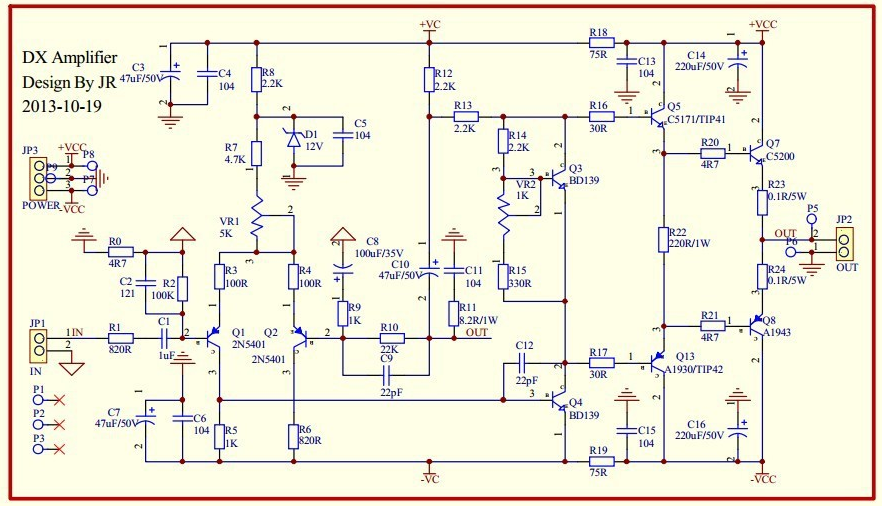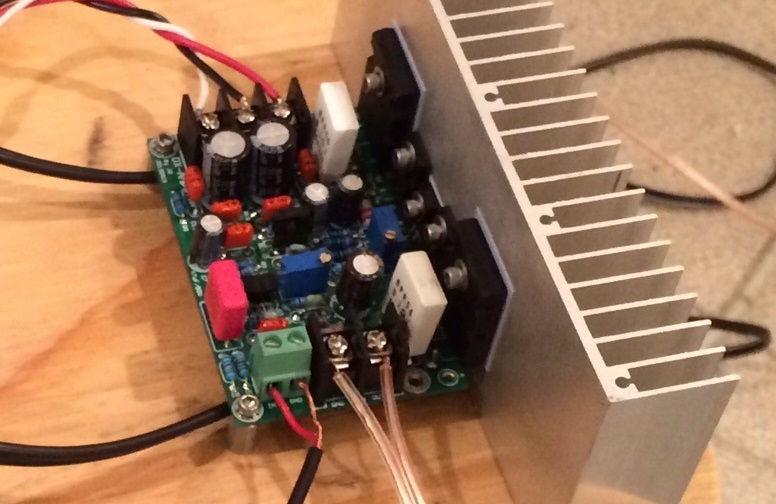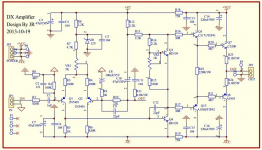What is the Max allowable DC offset for a Power amplifier- 100W or so.
I know it's not an exact science, but there should be a limit!? I'm feeding a 4ohm speaker. With the speaker connected I measure 40mV. Don't see any speaker excursions.
I know it's not an exact science, but there should be a limit!? I'm feeding a 4ohm speaker. With the speaker connected I measure 40mV. Don't see any speaker excursions.
You are right about the 'not an exact science' bit. Some would have you believe any DC offset is unacceptable, others ate more liberal. IMHO, I would suggest there is no hard fault if it is 100mV or less, but pursuing a lower DC offset than that is good practice. I like to see offsets less than 25mV in general practice.
Member
Joined 2009
Paid Member
If the range of DC offset when measured by the specified method is +-XYmVdc from cold to fully warmed up for Ta between 0degC to 40degC and you measure a random sample at >XYmVdc then you know that either you have measured it incorrectly, or the amplifier is faulty. Get it fixed, if it is outside specification.
Knowing that it is 40mVdc is only half the story. What are the specification limits?
Knowing that it is 40mVdc is only half the story. What are the specification limits?
my amp witout music 4mv after full power rise to 200mv 4ohm 100watt amplifire what wrong.
sorry my bad english
sorry my bad english
No big deal, just within the safe area.
I suspect not well matched differential input transistors , low current gain in the first one or some thermal problem .
Post the schematic you use.
I suspect not well matched differential input transistors , low current gain in the first one or some thermal problem .
Post the schematic you use.
the same dx blame st amplifire output 2sc5200 and 2sa1942 drivers bd139& bd140
input differintial bc546b and current mirror bc556b
input differintial bc546b and current mirror bc556b
The right question would be rather about Max allowable DC offset for...speakers.😉
Agree on this, also what really is destructive to speakers was it the DC voltage or the DC current?
It's a point of a properly working amplifier really ought to have >50 mV of DC offset. It's not speaker damage you should be worrying about. Most designs should really have a balanced differential pair and would normally sit less than 30 mV.
If your DC offset drifts with temperature, the diff pair is not well matched at all. They should also be in thermal contact with each other. Some heat shrink tubing will keep them in contact and also reduce the effects of air currents.
Match your BC546b transistors. They need to be at the same temperature in order to match the readings. If they are read when they are not at the same temperature, the readings will be way off.
-Chris
If your DC offset drifts with temperature, the diff pair is not well matched at all. They should also be in thermal contact with each other. Some heat shrink tubing will keep them in contact and also reduce the effects of air currents.
Match your BC546b transistors. They need to be at the same temperature in order to match the readings. If they are read when they are not at the same temperature, the readings will be way off.
-Chris
The reason I asked is that in our local forum some member has reported that they have actually measured an almost 200mv of DC offset, but still the amp is playing good music 😱
Hi abetir,
That's entirely possible. However, the term "good" is relative. Offset like that means the diff pair is not doing it's job.
I would consider an amp with 200 mV of DC offset as broken, needing repair. No ifs, ands or buts there. It needs to be fixed.
-Chris
That's entirely possible. However, the term "good" is relative. Offset like that means the diff pair is not doing it's job.
I would consider an amp with 200 mV of DC offset as broken, needing repair. No ifs, ands or buts there. It needs to be fixed.
-Chris
I never match transistors, although I generally use fairly high gain types picked from the same tape. In my designs the offset is never more 2mV across the operating range and usually much less. No servo.
50mV seems rather high, and although it isn't going to cause damage to the driver, indicates that the input pair is imbalanced.
50mV seems rather high, and although it isn't going to cause damage to the driver, indicates that the input pair is imbalanced.
Hi abetir,
That's entirely possible. However, the term "good" is relative. Offset like that means the diff pair is not doing it's job.
I would consider an amp with 200 mV of DC offset as broken, needing repair. No ifs, ands or buts there. It needs to be fixed.
-Chris
Hi Chris,
I do think "good" meant to be no audible distortion.
Thank you for the advice.
Regards!
Hi abetir,
That is still a relative term where a judgement in distortion is considered. Humans are not walking THD meters. I'm not being critical at all. I'm just pointing out that it isn't working to its full potential. The fix in this case is pretty straight forward.
-Chris
That is still a relative term where a judgement in distortion is considered. Humans are not walking THD meters. I'm not being critical at all. I'm just pointing out that it isn't working to its full potential. The fix in this case is pretty straight forward.
-Chris
It's a point of a properly working amplifier really ought to have >50 mV of DC offset.
>50mV? That means "greater than" 50mV. I think you mean <50mV.
This seems like a common mistake, so how can one remember the proper usage? As a kid I was taught this mnemonic to remember which is which: "the mouth of the crocodile always opens to the bigger meal". This means that the opening of "<" or ">" is always towards the bigger quantity. Less than and greater than are inequalities, which compare TWO things, typically some variable and a reference number. Very often the variable is omitted and is implied from context, like the DC offset voltage in this case. The symbol is almost always placed to the left of the reference number so when it is used like this
< number_cited
the number is greater than the quantity you are comparing it to, so the quantity is LESS THAN the number. Conversely:
> number_cited
In this case the number is less than the quantity you are comparing it to, so the quantity is MORE THAN the number.
It helps to create the full inequality in your mind until the usage of "<" and ">" becomes clear and automatic.
I'm not a stickler for usage, but thought that the mnemonic might help someone who reads this.
Last edited:
Possibly related to what is happening here but I have just built a Dx-clone amp (Similar to the Dx, but with some changes to the transitors and a few resistor values vs the official schematic), and am adjusting the bias now. There are two pots VR1 and VR2, and adjusting the VR2 to achieve 5mV across R24 (the emitter resistor) seems to have little effect whereas the VR1 has a large effect (sensitive). I managed to get 5mV across R24 (equal to 50mA quiescent current) and the offset at speaker out to be 5mV. The amp plays music and the heatsinks are cool (as opposed to really hot when I was turning one of the pots through the range to find where the 5mV spot was). However, I am noticing a sibillance or ringing in the treble range. It sounds like a slight time-delayed "tizzz" sound on high notes. The bass and mids sound fine. It is the same on both left and right amps - is this a symptom of poorly adjusted bias current, or could it be bad transistors, caps, etc.? The same symptom is on both amps so I don't think it is a single part failure.

Here is a photo of the assembled amp:


Here is a photo of the assembled amp:

Attachments
Last edited:
Possibly related to what is happening here but I have just built a Dx-clone amp (Similar to the Dx, but with some changes to the transitors and a few resistor values vs the official schematic), and am adjusting the bias now. There are two pots VR1 and VR2, and adjusting the VR2 to achieve 5mV across R24 (the emitter resistor) seems to have little effect whereas the VR1 has a large effect (sensitive). I managed to get 5mV across R24 (equal to 50mA quiescent current) and the offset at speaker out to be 5mV. The amp plays music and the heatsinks are cool (as opposed to really hot when I was turning one of the pots through the range to find where the 5mV spot was). However, I am noticing a sibillance or ringing in the treble range. It sounds like a slight time-delayed "tizzz" sound on high notes. The bass and mids sound fine. It is the same on both left and right amps - is this a symptom of poorly adjusted bias current, or could it be bad transistors, caps, etc.? The same symptom is on both amps so I don't think it is a single part failure.

Here is a photo of the assembled amp:

Vr1 is off set (Balances the input pair) VR2 is bias - you may have it set too low and hence the harshness. You have to measure across the emitter resistors, not to ground when setting the bias. VR1 could affect bias a little, but not very much IMO.
- Status
- Not open for further replies.
- Home
- Amplifiers
- Solid State
- Max allowable DC offset for power amplifier

